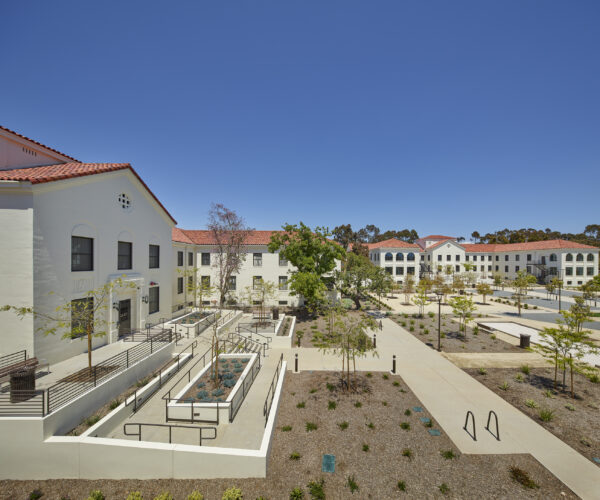
Place
Casa de Rosas Campus
Like the roses that once adorned its façade, the historic Casa de Rosas Campus—once the oldest women’s shelter in Los Angeles—blooms once more to serve an urgent community need, this time as long-term affordable housing for veterans.


Place Details
Address
Get directions
Architect
Year
Style
Decade
Designation
Property Type
The historic Casa de Rosas Campus, located near the University Park and Adams–Normandie HPOZs, has filled the needs of its community since 1893. The four-building Mission Revival style complex has been everything from a private kindergarten to a fancy hotel to military barracks for more than one hundred years.
Casa de Rosas is now beginning its next chapter: safe, supportive housing for veterans. Designed by master architect Sumner P. Hunt in 1892—one year before Hunt designed the legendary Bradbury Building — Casa de Rosas’ Mission Revival design marked a transition away from popular Victorian-era styles and was praised by contemporary magazines.
It was purpose-built as a private kindergarten, The Froebel Institute, which led the “kindergarten movement” in Los Angeles. The Froebel approach to young education was so popular that “kindergarten” was soon incorporated into the public-school curriculum and enrollment at the Froebel Institute fell. After the War, social crusader Essie Binkley West, known as “the Angel of Skid Row,” bought the property as the home for a new women’s mission, “Sunshine Mission.” It was the first shelter exclusively for unhoused women in Los Angeles, and for sixty years, it helped educate young women until dissolving in the late 2000s. The campus sat vacant for years, exacerbating existing damage from arson fires, vandalism, and the 1994 Northridge earthquake.
After a construction company mistakenly began demolishing a part of the complex in 2016, the interior features of one of the buildings were left open to water damage, dry rot, and mold. In 2015, the Housing Community Investment Department of Los Angeles (HCID) issued an RFP to redevelop the site, and the winning development team set out to create urgently needed affordable housing for veterans by using sensitive infilling, retaining the open space between the buildings, and avoiding the demolition of the badly damaged northeast building. To receive the Federal Rehabilitation Tax Credit, the project team collaborated closely with the Office of Historic Preservation and the National Park Services to meet the Secretary of the Interior’s Standards for Rehabilitation. Historic spaces and character-defining features were retained and restored, and sensitive updates were made to meet the community’s needs.
The $18-million restoration effort successfully rehabilitated the four historic buildings into 37 residential units—studios, one and two-bedroom units—plus management offices, common spaces, laundry rooms, and fitness rooms. The project also included seismic strengthening and reconstruction of damaged roofs, floors, and stairs. The Casa de Rosa’s exterior aesthetics and landscaping were restored using historic photos. Today, Casa de Rosas offers safe, permanent supportive housing for homeless veterans and their families. The latest chapter in Casa de Rosas’ history shows what can be achieved when preservation is used to uplift marginalized groups while celebrating local L.A. history.
The Conservancy recognized Casa de Rosas’ epic rehabilitation—and the crucial need it serves for L.A.’s unhoused veterans—with a Preservation Award in 2022.
Casa de Rosas Campus earned a 2022 Preservation Award


